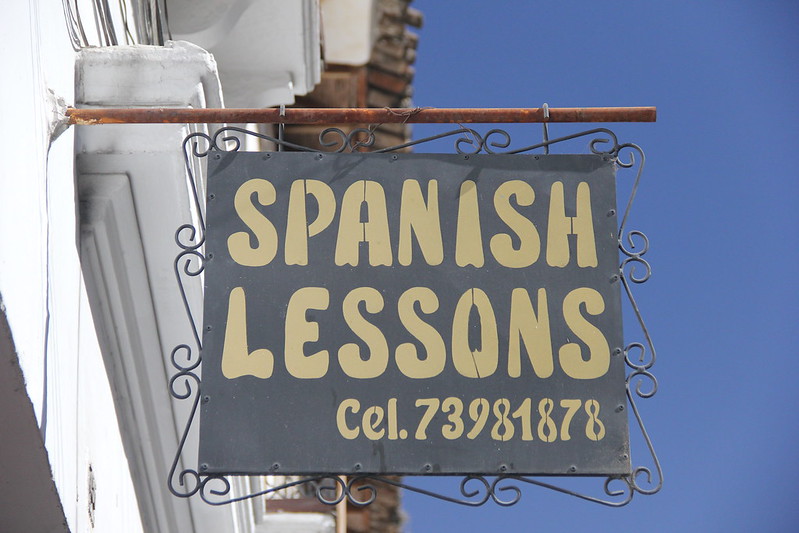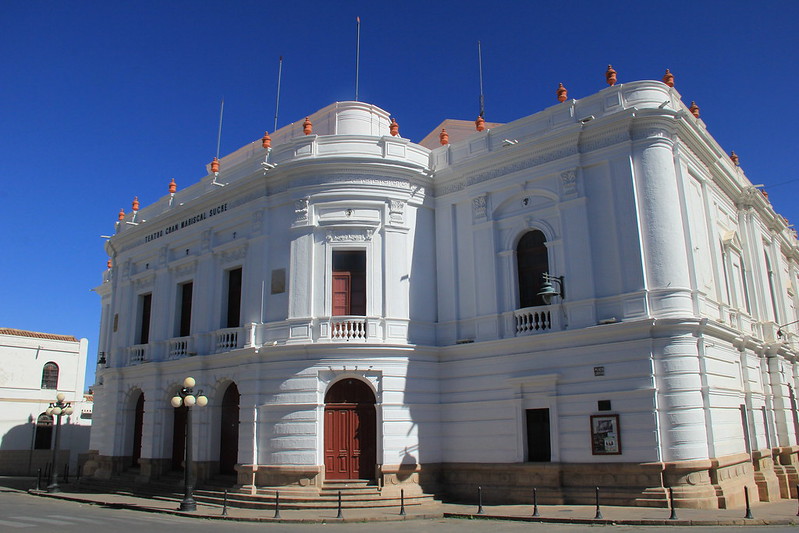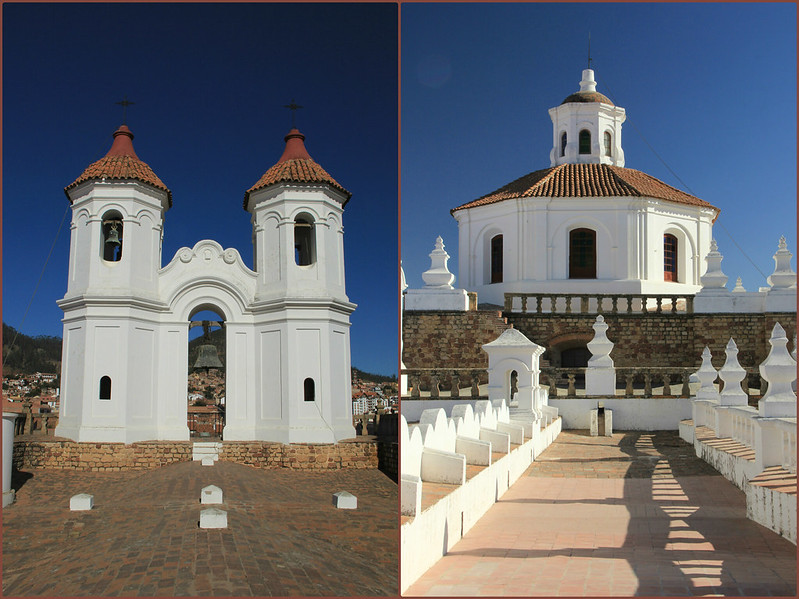Believe it or not I actually studied for (and achieved; grade B!) a Spanish GCSE qualification in 2013.
I didn’t have the option to study the language at school (even though it was the only one I wanted to learn at the time), so before that my level of competency didn’t extend beyond the usual niceties and ordering basic foodstuffs in restaurants.
However I’d received my notification of redundancy at work (as had everyone who worked in one of the company’s ‘local offices’ around the UK), and – in addition to our redundancy pay-out – we were all compensated with the opportunity to take a vocational course or study for an academic qualification. The only stipulation was that we had to justify how said course or qualification would help us in the progression of our careers – whether those careers continued along the same direction as our current roles or branched of in a ‘slightly’ different one.
All I wanted to do when I left that job was use my redundancy money to travel around South America and blog about it along the way. I hadn’t got a clue in the world what I would do with my life when I returned. But somehow I managed to convince the powers that be that a vocational course in web design, a GCSE in Spanish, and an online Journalism diploma were going to help me in my future career.
I sacked the Journalism diploma off after the first few weeks of discovering that it really wasn’t for me (not sure whether that was the course itself or journalism!), the web design course has proven to be only marginally useful, but the Spanish GCSE greatly improved my reading and writing skills, and started to give me a very basic understanding of the language.
Due to the course being solely online though, my speaking and listening skills were seriously subpar. So I enrolled on a beginner’s Spanish course with one of the schools in town, hoping that the group sessions would help to build my confidence in speaking the language, and also in understanding the responses I was given.
Whilst I did learn a lot and my diction and pronunciation improved no end, I still failed to understand more than a few words of Spanish conversation.
So, when I left for South America in April 2014 I knew I wanted to study some more, and a few days in Lima only served to highlight that I NEEDED to study more. Therefore it was always my intention to stop somewhere and take lessons for a few weeks solid.
The problem was that I got so caught up with sightseeing, and attempting to fit everything that I wanted to see and do in Peru into our short 3-month window (when I’m travelling long-term I like to properly delve into a country beyond its main tourist attractions) that I didn’t find the time to do that. It also didn’t help that my boyfriend Stu (with whom I was travelling) had no desire to take lessons himself. So the subject kind of got avoided for the entire time we were in Peru.
I suppose I sort of expected my Spanish to improve naturally, being in a country surrounded by Spanish speakers, but it didn’t – or at least to nowhere near the level that I’d hoped it would.
So when we arrived into Bolivia, and Stu discovered that he was going to be required back in England a lot sooner than we’d planned, I figured that would be my ideal time to stop and put some roots down somewhere for a few weeks. We’d tick all the tourist sites off first of all (Lake Titicaca, La Paz, Death Road, Potosí, Salt Flats) and then I’d stop in Sucre whilst he headed home. He wasn’t so keen on this idea, but it was something I desperately wanted to do so I fought my corner, and I’m so glad I did.
After months of constant travelling, it was lovely to find somewhere I could call home – even if only for a few weeks.
Although Sucre is Bolivia’s official constitutional capital, it’s a small city with a population of just over 300,000, and the centre is walkable, safe, and aesthetically beautiful. It’s not called ‘The White City’ without reason.
I researched Spanish schools in the city (of which there are lots!) and finally went with a recommendation from a fellow travel blogger, The South America Spanish School. They weren’t one of the major schools; they were a small family-run business who were praised for their friendly, intimate learning environment and flexible working patterns.
When I arrived in Sucre I had a chat with the owner Bertha (a completely lovely lady I’ve kept in touch with via Facebook since leaving) who set me up with a tutor and my lessons started that afternoon.
If you’re also thinking of taking Spanish lessons in Sucre, here are a few things you should know.
How much do lessons cost?
I paid B45 (£4.11) per hour for private one-to-one tuition, compared to AT LEAST £20 per hour for the same thing back here in the UK.
What are the advantages and disadvantages of group verses private tuition?
Having previously taken group lessons in the UK before travelling to South America, I would definitely recommend private tuition over group lessons, if you’re serious about progressing your language skills.
Yes, group lessons can be a fun, sociable activity, but only a small percentage of that hour you’ve paid for will be focussed on you (as the tutor must spread his or her time equally between all group members), and there’s also the danger of constantly comparing yourself to others, which can be distracting and disheartening.
Although I took private lessons, I could socialise with other students during break times and after lessons. My Spanish school also laid on extra curricular activities such as market visits, film nights, and cooking classes (more on that later).
How flexible are the timetables?
Obviously if you sign up for group lessons, the timetables have to be fixed, but if you choose private tuition, your tutor is very flexible, and timetables can be arranged and amended to suit your own travel schedule and learning ability.
I chose how many hours I wanted to study each day, and at what time I wanted to take these lessons. And I could amend this on a day-to-day basis if I chose to. For example, if I felt that three hours was too much, I could drop it to two, or if I felt like I needed to put in more hours, I could up it to four or five per day.
Think about the time of day that tends to be your most productive and consider your own concentration span when it comes to successfully absorbing new information. You don’t have to take lessons on a daily basis but I would recommend it.
Will I have homework to complete?
The likelihood is yes, because your tutor needs to find out how much of the lesson information you’re absorbed and understood in order to plan any future lessons. He or she needs to determine where your strengths and weaknesses lie so that they know which areas of the language need work.
I found that my homework would generally take between one and two hours per night, but that I would spend a little extra time re-visiting the lessons, because the more you put into learning a language, the more you get out of it. And language learning is definitely not something that comes naturally to me.
Is there the option of a home-stay, in order to submerge myself into the language even further?
Yes. I can’t speak for other Spanish schools but the South America Spanish School offers the option of a home-stay, with the school owner, Bertha, and her family. I didn’t choose this as I wanted my privacy and independence (there was only dorm-style accommodation available at Bertha’s) and I wanted to stay in the centre of the city.
However, having seen how much faster the language skills of those who chose the home-stay were progressing in comparison to my own, I started to see the benefits of choosing this option.
Will I have the option to take part in extra curricular activities?
Yes. In my opinion any Spanish tutor who is dedicated to the education of his or her students, will recognise the value in using the language outside of lessons, in an environment where they will feel supported and at ease.
I was taken to a local market one morning with the other students and tutors from my school, and we were encouraged to converse with the market vendors in order to gather ingredients for the meal we would all be helping to cook at Bertha’s house that same. If we got stuck there would always be tutors on hand to translate for us, or to correct our own grammar and pronunciation.
Another night we watched a Bolivian film, The Devil’s Miner, an insightful and moving documentary in which a 14-year old boy tells the story of his life as a Potosí miner. Although we watched it with subtitles, it was a great way of getting used to the sounds of the language, and honing our listening skills.
What can I do to practice in between lessons?
If you stay in a private room in a hostel or hotel in the centre of Sucre, it’s very easy to get by on a day-to-day basis without speaking more than a few words of Spanish. Hostel and hotel owners will often have a fairly good grasp of the English language (although not in the case of my hostel – which was a GOOD thing), as will restauranteurs and cafe owners.
I often found that, despite attempting to construct my visits to cafes and restaurants entirely in Spanish, the staff would recognise my English accent (and the fact that, well, I don’t look remotely Spanish – reddish hair, fair skin, freckles) and speak back to me in my native tongue. And then, it’s obviously all to easy to go along with that. It is after all, a lot simpler to be able to converse in a language you grew up with.
But, you really must put that lack of confidence and complacency aside if you want to move forward. So tell the waitress or shop assistant,
“Estoy aprendiendo español aquí en Sucre, por lo que podemos hablar en español por favor?”
(I am learning Spanish here in Sucre, so can we speak in Spanish please?)
Or I’d often tell people I was learning and ask them to speak “más lentamente” (more slowly), which actually really helped A LOT.
Visiting the local market was also a great way to practice, as it’s rare to find a market vendor who speaks or understands more than a few words of English. You can also point and ask the names of various different produce,
“¿qué es esto/eso en español?
(what is this/that in Spanish?)
I usually visited the market every afternoon to buy a few pieces of fruit to snack on and a couple of paltas (avocados) to accompany the huevos revueltos (scrambled egg) and chapla (flatbread) that I was served for breakfast at my hostel the following morning.
So how much can you learn in three weeks of lessons?
I’m not going to lie, I’ve still got a (very) long way to go, but I do finally feel like the basic concepts of the language are finally starting to slot into place, my vocabulary and confidence has grown exponentially, and I can hazard a fairly good guess at the appropriate tenses to use in any given situation.
But bear in mind that I did study the language for eight months previously and I did attend 12 weeks of group lessons after that. So I wasn’t a complete beginner when I began my studies in Sucre.
The trouble is that since returning from Bolivia in autumn 2015, I’ve not used the language at all – apart from during a brief trip to Spain, to visit Granada and to take a mini road trip through Andalusia’s pueblos blancos (white towns).
I took a job that paid little more than minimum wage, so if I wanted to continue travelling I had to cut back on non-essential expenditure. And unfortunately that meant that I could not afford to take further Spanish lessons.
But with a new year upon us, and a trip to Spain and Cuba on the cards (in fact I’m actually going to be in Madrid when this post is published), I’ve made a concerted effort to re-visit the language and improve my knowledge and skills. I’ve started sorting my old old notes into some semblance of order and building some verb conjugation charts.
I’ve also installed the Duolingo app on to my mobile phone. Duolingo is a free language-learning app that gives you bite-sized lessons to complete on a myriad of different topics from adverbs to adjectives, and possession to pronouns. You have daily target to reach, you earn points for correct answers and you complete some tasks against the clock. You can even invite friends, compare scores and compete against each other.
It puts the fun into language learning and I warn you, it’s seriously addictive!
Have you tried to learn a language recently? Are you taking lessons at the moment? Do you have any tips or recommendations to help me along my way?
If you like this article, please follow along on Facebook, Twitter, or Google+ or you can look me up on Instagram or Pinterest too!














3 Comments
Those are some nice looking photographs!
And Duolingo do a great job making language learning feel like a game!
muy interesante, en especial – precio! Una amigo me dijo de Sucre para el aprendizaje de Espanol. su articulo es muy informativo. me gustaría hablar y comprender muchisimo mejor! quizas lo podría pasar en Sucre! muchas gracias!
Sucre es un gran lugar para aprender español. Una ciudad tan preciosa tambien 🙂